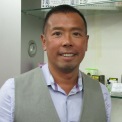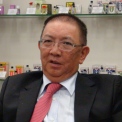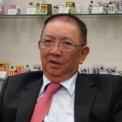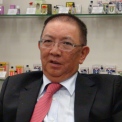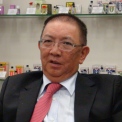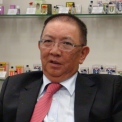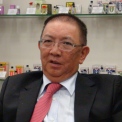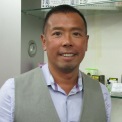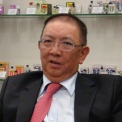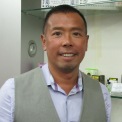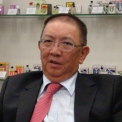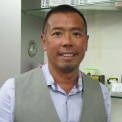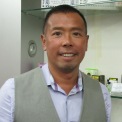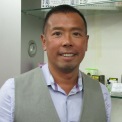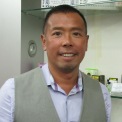-
History & Society
- Education in Pre-war Hong Kong
- History of Taikoo Sugar Refinery
- Hong Kong Products Exhibition
- Local Festivals Around the Year
- Post-war Industries
- Pre-war Industry
- The Hong Kong Jockey Club Archives
- Tin Hau Festival
- Memories We Share: Hong Kong in the 1960s and 1970s
- History in Miniature: The 150th Anniversary of Stamp Issuance in Hong Kong
- A Partnership with the People: KAAA and Post-war Agricultural Hong Kong
- The Oral Legacies (I) - Intangible Cultural Heritage of Hong Kong
- Hong Kong Currency
- Hong Kong, Benevolent City: Tung Wah and the Growth of Chinese Communities
- The Oral Legacies Series II: the Representative List of the Intangible Cultural Heritage of Hong Kong
- Braving the Storm: Hong Kong under Japanese Occupation
- A Century of Fashion: Hong Kong Cheongsam Story
Geography & EnvironmentArt & Culture- Calendar Posters of Kwan Wai-nung
- Festival of Hong Kong
- Ho Sau: Poetic Photography of Daily Life
- Hong Kong Cemetery
- Sketches by Kong Kai-ming
- The Culture of Bamboo Scaffolding
- The Legend of Silk and Wood: A Hong Kong Qin Story
- Journeys of Leung Ping Kwan
- From Soya Bean Milk To Pu'er Tea
- Applauding Hong Kong Pop Legend: Roman Tam
- 他 FASHION 傳奇 EDDIE LAU 她 IMAGE 百變 劉培基
- A Eulogy of Hong Kong Landscape in Painting: The Art of Huang Bore
- Imprint of the Heart: Artistic Journey of Huang Xinbo
- Porcelain and Painting
- A Voice for the Ages, a Master of his Art – A Tribute to Lam Kar Sing
- Memories of Renowned Lyricist: Richard Lam Chun Keung's Manuscripts
- Seal Carving in Lingnan
- Literary Giant - Jin Yong and Louis Cha
Communication & Media- Hong Kong Historical Postcards
- Shaw Brothers’ Movies
- Transcending Space and Time – Early Cinematic Experience of Hong Kong
- Remembrance of the Avant-Garde: Archival Camera Collection
- Down Memory Lane: Movie Theatres of the Olden Days
- 90 Years of Public Service Broadcasting in Hong Kong
- Multifarious Arrays of Weaponry in Hong Kong Cinema
-
History & SocietyGeography & EnvironmentArt & Culture
-
View Oral History RecordsFeatured StoriesAbout Hong Kong Voices
-
Hong Kong Memory
- Collection
- All Items
- Oral History
Recently VisitedOral History
In the old days, Gan Fock Wai’s father had good connection with many Cantonese opera artists and movie stars such as Sun Ma Sze Tsang, Chan Po Chu and Wu Fung. He even pledged brotherhood with top film directors who were happy to allow Pak Fah Yeow billboards to appear in their movies, as a way to promote the product brand. Back then, a lot of Cantonese opera artists and movie stars loved using Hoe Hin products. Those who are still alive today remain very supportive to Pak Fah Yeow. In the 1970s, Hoe Hin invited Teresa Teng to serve as Hoe Hin’s Charity Queen. Teresa was about 17 years old at that time and had just come to Hong Kong for further development not long after she started her career in entertainment. Gan Fock Wai knew Teresa well and the two young people had played table tennis together when Gan was in Primary Five and Six. Gan Fock Wai thought his father had a very good business mind and used a lot of progressive ideas to successfully transform a simple medicated oil into a best-selling brand.
In order to successfully market Hoe Hin products such as Pak Fah Yeow, Gan Fock Wai began trying out new ways of promotion. To this end, he put more emphasis on repositioning Pak Fah Yeow as a multi-purpose product whose usefulness went far beyond that of regular pharmaceuticals. In expanding its uses, Gan Fock Wai explained that if Pak Fah Yeow was marketed as a medicine, people would use it every time they felt unwell because of headaches, mosquito stings or insect bites. Going beyond a purely pharmaceutical positioning, Gan Fock Wai told people that Hoe Hin’s star product could be used to refresh the complexion, relieve emotional tension and even soothe heat stroke or dizziness while one waited for the bus or did the Christmas shopping! In Hong Kong, Hoe Hin had registered Pak Fah Yeow as a proprietary Chinese medicine. While it focused on the product’s extensive applications in its promotional efforts, the company never exaggerated its curative effects. Gan Fock Wai hoped to expand the uses of the brand so that consumers would pop a bottle in their purse or pocket to take with them for their own use or even help others while out and about. Examples of the latter type of usage could include giving some Pak Fah Yeow to a stranger in the street who was feeling discomfort or heat stroke. Emphasising such versatility was a sure way of helping to increase sales.
Gan Fock Wai describes that he had inherited his father's practice of never forgetting to convey a positive message in Hoe Hin’s promotional materials. About 10 years ago, Hoe Hin launched a series of TV commercials which were on show immediately before the news reports on two free-to-air local TV stations. Each day Hoe Hin sent a message featured a slightly different jingle such as “Letting Go Is Happiness”. The company also sponsored 13 episodes of Commercial Radio Hong Kong’s popular Spiritual Environmentalism programme. Occasionally, Gan Fock Wai hosted the show himself, inviting different guests to share uplifting spiritual stories and their wise advice about life.
Many years ago, Gan Fock Wai served as the lead singer on popular Hoe Hin commercials, such as “Go Fly”. Four years ago he returned to the recording studio to record “Love 80 Years More” to celebrate Hoe Hin’s 80th anniversary. Beginning in the 1980s, Gan Fock Wai had released several albums, initially singing for fun. He later learned to love music even more and began using it to convey positive messages. In last Lunar New Year Fair, Gan Fock Wai sold an album called “Music Recycle” to raise charity funds for Friends of the Earth. The album mainly featured him re-singing old songs aimed at reminding fans to recycle and reuse. The song “Go! Go! Go!” was intended to convey a message about the environment. Gan Fock Wai later planned to record a new album on behalf of the Society for Abandoned Animals to help call for the better protection of animals. The formulation was based on weight. Ingredients were measured on old-style balancing scales. Ingredients included menthol, camphor, lavender, eucalyptus, peppermint, etc. They were imported from around the world including Australia, China, India, etc. The formula remained largely unchanged to maintain the same smell of Pak Fah Yeow. Yet the company gave up some potential markets due to the restriction by the local government against certain chemical components. Gan preferred to keep the same formula because otherwise it would no longer have the unique smell of Pak Fah Yeow.
The mixing of the ingredients used to be carried out only by Gan’s grandfather and grandmother at the back of the house. This ensured the formula to be kept as a secret from the workers. Modern technology allows a close prediction of the formula by chemical assay, so now building up a good brand name is of greater importance.
Gan’s grandfather mainly used the trade fair (products exhibitions) to build up the image of Pak Fah Yeow. Pak Fah Yeow was an active participant in the trade fair from the 1950s to 1970s. Gan’s grandfather targeted at the general public to promote the product. He was eager to win the first prizes in the fair to increase the brand’s popularity. He tried to build the biggest and the most eye-catching booth in a traditional Chinese style with good lighting. He also knew a lot of movie actors and actresses so he engaged the actresses as charity queens at the booth for promotion. The charity queens did not parade on stage, they just stood at the booth and collected votes from visitors. He always managed to win most of the titles: the best booth design and the best charity queen representative of Pak Fah Yeow. He also gave away free gifts such as hot water flasks and doll-shaped-bottle editions to bigger buyers. The aim of participating in the trade fairs was not for the sales profit but for the exposure to the public.
Gan Wee Sean was born in Penang in 1946. His grandfather was born in China and his grandmother was born in Singapore. Gan’s grandfather started the Pak Fah Yeow business in 1927. The business was started in the same premise where the family was living in Penang. The place was rented at a low rate. The formula of Pak Fah Yeow was initially intended for uses among family and friends only, but as it grew popular among the people, Gan’s grandfather turned it into business. The sales expanded in Malaysia and later to Singapore. In the 1950s, as Gan’s grandfather saw the potential of the Chinese market, he moved the operations to Hong Kong because of her proximity to China.
The company was registered in Penang as a private company. Together with the trademark, they were named after Gan’s grandmother as Hoe Hin . At first she was the sole proprietor of the trademark but she later sold it to the company. Gan’s grandfather used to tell a story of a German professor giving him the formula of Pak Fah Yeow, but Gan believed that the formula should have come from his grandmother’s or great grandmother’s side. Like other medicated oils, Gan believed the formula originated in Malaysia and was not likely to have derived from Chinese medicine.
The earliest manufacture of Pak Fah Yeow was purely manual. Around 10-20 workers sat around a long table, and a few hundred dozens of bottles were produced in a week. Menthol crystals and camphor tablets were broken into smaller pieces and put into big wine jugs, dissolved in oil and then mixed and shaken by hand. Then the oil was sucked up and filled into small glass bottles using injection syringes. The paper package boxes were folded and glued by hands. Until today the shape of the bottles used at that time remained unchanged.
When Gan was in primary school, he helped out as a small boy after finishing schoolwork. The operation was on home-made scale and did not demand much skill. Workers were mainly family and relatives. Most were women workers, while male workers mainly did the heavy work.Before the operations were moved to Hong Kong, the factory had been in Penang only. Products were shipped to Singapore for sale. The factory in Hong Kong was first started in King’s Road, which was later moved on to Electric Road and subsequently to Hennessy Centre above the former Chinese Emporium. The place was later sold to the emporium and the factory was moved to Zung Fu Industrial Building in Quarry Bay. Gan also started a branch factory at Westlands Garden at Quarry Bay to guarantee continuous production in case accidents like fire or water suspension might jeopardize the whole production and the company couldn’t afford it. Yet later the government reclaimed the land of Westlands Garden for development. Both operations at Quarry Bay were then sold and merged into one operation in Paramount Building at Chai Wan.
Gan’s grandfather worked much on building up the brand image in Hong Kong. He joined the Chinese Manufacturers’ Association and actively participated in the past product exhibitions. He engaged movie actresses to promote the product and did a lot of outdoor promotion. In the old days, people could sell a product on the street by performing Kung Fu strokes. Gan believed that for a product to be successful, marketing strategies, adequate pricing and the effectiveness of the medicine were equally important factors.
When Gan Wee Sean came back to Hong Kong from his studies in the UK, the factories and office were already at Hennessy Centre. Machines were employed for mass production. The manufacture was semi-automatic. The oil was manufactured in bigger drums and the weighing machines were more advanced. The oil was mixed with big stirrer and filled into bottles with electric compression chamber. (Editor’s remark: “Compression pump” was used by the Interviewee but “vacuum pump” should be a more proper name. ) The capping, labeling and carton- packaging were still done by hand. Later when the operations moved to Chai Wan, the production were further automated. Since larger bottles had to be protected with bubble packs, the packing process remained manual. Even today packing is still done by hand.
When the production was done in Penang, Pak Fah Yeow was already sold in Hong Kong but by other company. Gan suspected that the products were taken to Hong Kong from Singapore through private channels. Gan’s grandfather visited Hong Kong in 1950s and saw the potential of the Chinese markets. He saw Hong Kong as a good port to produce and supply the products to China. In addition, Hong Kong herself had good market potential as the sales in Hong Kong were one of their largest. Gan’s grandfather decided to move the operations to Hong Kong in mid 1950.
As a child, Gan Fock Wai occasionally came to visit Hoe Hin’s Pak Fah Yeow factory. At that time, the plant was located on the third floor of the present Hennessy Centre in Causeway Bay. After the factory moved out, its floor was taken over by a department store and eventually became a food court. Pak Fah Yeow’s iconic signs can still be seen on the exterior walls of the Hennessy Centre to this date.
At that time, the production processes of Pak Fah Yeow were so simple that even a child could carry them out. The specific steps included injecting the medicated oil into bottles by syringe, immediately screwing on each bottle’s cap and then folding the printed cardboard packaging into boxes. Gan Fock Wai helped out at the factory when he was just aged 6 to 7. To make his time there more enjoyable, he turned humdrum tasks such as injecting medicated oil into bottles with a syringe into games and competed with workers to see who could fold boxes fastest.
Gan Fock Wai knew that many Hoe Hin workers retired at a very old age, but he had never heard of any of the company’s workers having occupational diseases. No matter whether the Hoe Hin factory was located in Causeway Bay or Quarry Bay, its production lines always produced a fragrance! When the plant’s windows were open, the scent would fill the neighbouring streets! Today, Hoe Hin’s plant has different clean rooms to filter odours, and has an ventilation system to purify the air. The current plant also utilises an enclosed design which stops aromas from spreading to outside the plant. As a more eco-friendly note, the plant processes waste materials according to environmental regulations and insists that all waste is recycled by waste management companies. In the 1970s, the office was shared by six people including Gan Wee Sean, Gan’s grandfather, one director, an accountant and a Chinese clerk. There were about 30 workers in the factory at Hennessy Centre. The production rose to 12,000 to 24,000 pieces per month. The production procedure remained largely manual except for the steps of filling, wrapping and carton-packaging. Promotion was mainly outdoors with very little use of TV commercials. The biggest promotion every year was at the trade fair (or products exhibition). The products were distributed by eight major Chinese medical halls in Hong Kong. Gan’s grandfather wanted to maintain good relationships with the eight owners so that he could benefit from a wider coverage of distribution through the different networks of these distributors. In 1991, the company changed from a family business to a listed company, although still under family control. He believed his grandfather would not have agreed with listing the company.
While there are several stories about the origins of Hoe Hin’s Pak Fah Yeow formula, no one knows which – if any – is true. One version has it that the formula was handed down by the family of Gan Fock Wai’s father's first wife, Low Khoon Choo. While still a boy, Gan Fock Wai also heard different versions from his father. They included a story about getting the formula from a friend whom Gan’s father got to know on board a boat while travelling overseas to sell biscuits. Another version says that Pak Fah Yeow’s formula was passed from Gan Fock Wai’s grandfather to his father.
Over the years, Hoe Hin made very few changes to its Pak Fah Yeow formula. The formula for white flower products to be exported was modified in order to comply with the regulations and specifications of the different regions for whence it was headed. In the Colonial past when the British still ruled Hong Kong, they did not control traditional Chinese medicine and many export regions did not regulate such products. Today, Hong Kong has implemented a stringent registration system for Chinese medicines. Countries around the world have different regulations for regulating traditional Chinese herbs and natural herbal lotions, potions, creams and infusions, etc. Nowadays Hoe Hin also complies with the latest pharmacopoeia standards when procuring different natural raw materials each year. Taking lavender oil as an example, Pak Fah Yeow once used to feature synthetic lavender oil, but now complies with the latest British Pharmacopoeia standards governing the procuring of such oils. In buying natural raw materials, Hoe Hin insists on globally-recognised pharmacopoeia standards. Specific examples include the Chinese, British, U.S. and European Union Pharmacopoeias. The aim is the constant improvement of its products’ quality.
The natural raw materials that Hoe Hin uses are all purchased overseas and many factors are considered before importing into Hong Kong. Nowadays, the price of natural raw materials are very high due to many different reasons. Pollution causes climate change, affecting cultivation and leading to soring prices of many natural products. For example, when the Australian weather becomes increasingly dry, locally produced natural raw materials diminish in quantity and the prices rise. As a result, farmers prefer to grow agricultural products that are easy to sell and can make profits. To this end, they grow fewer medicinal plants such as mint, causing prices to rise due to the short supply of medicinal plants. As the prices of such plants increase, there are farmers who switch to grow medicinal plants to meet demand. Even so it may not be able to relieve the problem because it takes time for the soil to become suitable for growing medicinal plants within a short period of time. Other factors such as excessive harvesting of wild cordyceps sinensis causing desertification, affecting agricultural harvests and also pushing up the prices of natural raw materials. U.S. dollar exchange rate fluctuations, inflation, metal prices, energy charges and other factors such as the cost of producing glass bottles, plastic caps and packaging all have direct impacts on prices. Each variance has a “knock on” effect that affects prices at every stage of the production chain.
Aside from directly importing from Australian farmers, Hoe Hin generally imported raw materials through intermediary trading companies. Gan Fock Wai believed that for Hoe Hin to achieve sustainable development, it would have to put sound environmental protection measures into practice and make every effort to protect the natural raw materials. He hoped that in addition to achieving Good Agricultural Practice (GAP) compliance, Hoe Hin would also adhere to the principles of fair trade in its future sourcing of raw materials in order to protect the livelihood of the farmers who produced them.
Gan thought he treated his staff in a nice way, but he wouldn’t describe it as a family culture. The staff was stable, most with long employment. He believed there was no dissatisfaction among the staff. For example, Gan’s personal manager had worked as his personal assistant since 1974 when she was 18. The Company’s Chief Operating Officer had been working here for nearly 20 years. One of the company’s directors, now retired, had worked for the company since he was 18 until he reached the retirement age of 70. Now he had become one of Gan’s best friends.
Most of the staff has been working for the company for over 3-4 years, and many of the factory workers have been serving for more than 10-15 years. Since the old workers were more familiar with the machines (although they did not have strong educational background), sometimes they were more helpful than the newly recruited educated technical staff. Currently, there were about 120 employees in the company: about 100 factory workers and 20 office employees. About 80% of the workers were women. The few men workers mainly carried out heavy duties such as loading and unloading. Gan Fock Wai took pride in introducing GMP into Hoe Hin. Studying food engineering in the UK in the 1980s, he learned that food factories there had to achieve minimum GMP standards. Returning to Hong Kong after graduation, he began to work as a technical salesman with Edward Keller, noticing that many pharmaceutical or food factories in Hong Kong did not meet the GMP minimum. After joining Hoe Hin, Gan Fock Wai did his utmost to introduce the concept of GMP into the company. When Hoe Hin subsequently implemented Australian GMP in 1996, it was at a time when Hong Kong people knew very little about the standards.
At the beginning, Gan Fock Wai introduced GMP standards Hoe Hin step by step. It was only when the company sought to export its products to Australia and the Australian authority inspected its factory that it applied in full the GMP standard to its production management. The company hired an American engineer and moved to a new factory premise. The hardware facilities were completed upgraded to meet the GMPrequirement. In addition to upgrading its hardware, the company also attended to its software requirements. Specific examples included documentation system, testing of raw materials, production process and products as well as recycling measures should problems arise in product quality.
Gan Fock Wai believed that factories using fully manual operations could also satisfy the requirements of GMP and create no pollutants. When a factory applies machinery in production, it should clean the machinery parts thoroughtly and frequently. Otherwise the residues of raw materials left in the machines would combine with each other and produce unexpected pollutants. As Hoe Hin’s products use natural raw materials such as strong antibacterial materials like eucalyptus and lavender oil and its products are comparatively simple, production processes and quality are easy to control. Even the company adopted purely manual production processes, it seldom had the problem of producing unexpected pollutants..
To meet GMP’s requirements, Hoe Hin had to provide training for all of its workers at every level. It was the responsibility of factory manager and quality assurance manager to provide training and to remind the workers of what they had to pay attention to. For example, workers should wear sanitary caps to keep their hair from exposing in the air; after using the washroom workers had to clean their hands and apply sterilizing agents before going back to the workshops; packets had to be discarded if they had fallen onto the floor and workers had to wash their hands again.
After obtaining GMP certification in 1996, Hoe Hin became a role model in Hong Kong, with many local schools asked for organizing visits to Hoe Hin’s factory for their students. When the Department of Health arranged visits to local pharmaceutical companies for foreign organisations and company representatives, they frequently picked the Hoe Hin plant as a point of visit. Dr. Margaret Chan, the then Director of Health had invited Gan Fock Wai to join the Chinese Medicine Council of Hong Kong after she visited Hoe Hin’s factory.
Gan Fock Wai has always believed that Hoe Hin’s long history has been one of its greatest strengths. Simplicity is another reason why the company’s products have a long life and sales remain good. Hoe Hin’s best-sellers include Hoe Hin White Flower Ointment, Hoe Hin Strain Relief, Fook Zai 239 and – most profitably of all – traditional Hoe Hin Pak Fah Yeow White Flower Embrocation (Pak Fah Yeow). Fewer product types ensure simpler, more streamlined management and operational procedures that offer Hoe Hin many benefits. In terms of production, the company’s warehouse does not need to maintain a vast inventory and there is no need to store different types of packaging and raw materials. When procuring raw materials, it is also easy to understand price movements. The process of buying packaging materials is equally straightforward. As production processes are also simple, manpower control is easy. In marketing, focusing on developing a product whose characteristics are well known and widely accepted greatly simplifies marketing strategy. It is also much easier to grasp market pricing. Gan Fock Wai has always been a firm believer that the many meritorious deeds Hoe Hin has done in the past helped to ensure its products enjoyed a long life. When his father Gan Geok Eng was managing Hoe Hin, the company had already actively participated in charitable activities that made many positive contributions to the community. Having learned from his father, Gan Fock Wai also took a keen interest in public welfare activities. To this day, Hoe Hin has sponsored deserving local welfare organisations with company products for many years.
Gan Fock Wai stressed that to achieve sustainable development, it was essential that Hoe Hin not only contributed to society, but also happily shouldered its social responsibility. As a result, he insisted that staff adopted eco-friendly practices in key operational areas such as production and sales. To this end, Hoe Hin did not participate in Hong Kong Product Expo for many years, considering that the booths there were made from materials which could not be recycled, resulting in creating a lot of garbage and waste. That said, Hoe Hin continued to participate in the Lunar New Year Fair since the design of its booths there was both simple and recyclable. Charity sales were also conducted from these Lunar New Year Fair, with all funds raised being donated to voluntary organisations such as the Senior Citizen Home Safety Association and the Society for Abandoned Animals. To achieve the goal of environmental protection, Hoe Hin needed to find consensus within the company. For example, Gan Fock Wai once proposed simplifying Hoe Hin’s product packaging in order to reduce waste. In doing so, he was faced with concerns that this might not be welcomed by consumers. When it came to marketing, Gan Fock Wai opposed the marketing department’s idea of running advertisements on paper pads in fast food restaurants considering such pads a waste of precious limited resources. He also suggested turning off Hoe Hin’s branded neon signs earlier in the evening to save energy. Here again, the company’s marketing department had different views from his.
Keeping products looking and feeling young remains Gan Fock Wai’s core principle in developing Hoe Hin’s products to this day. In his early days, Gan Fock Wai had developed some new products, but none was very successful. As a result, he thought that prolonging the life of existing products was a far more solid foundation for the future than investing a lot of resources in developing new and therefore untried products. In addition to promoting the image of Hoe Hin’s brands and establishing stable sales channels, Gan Fock Wai set out to raise the standard of the company’s entire production process. His aim was to ensure a good product quality that would prolong the life of both the company and its products.
When it came to sales channels, Hoe Hin used to have eight wholesalers who directly distributed its products in the local market. As a result, the company earned more profits because it did not have to pay intermediaries. Each of these wholesalers was a large pharmacy. Many of them had ceased operation when the proprietors grew old. Today, only a few like Chung Ching Dispensary are still operating. Hoe Hin now uses DKSH Hong Kong Limited (DKSH) as its sole distributor locally. Gan Fock Wai felt that DKSH worked well and had developed a successful, comprehensive marketing strategy for Hoe Hin products. With the markets changing over the time, there are now a variety of outlets selling medicines in Hong Kong. Apart from drug stores, people could buy medicines from supermarkets, convenience stores and personal care shops. It is difficult for Hoe Hin to manage different types of sales outlets and not efficient to rely on a number of distributors. It has now become much simpler and easier to let a single distributor to manage the entire sales operation. As a result, although DKSH’s distribution charged higher costs for marketing, it remains more cost-effective for Hoe Hin to use them to handle the local distribution of its products.
Hoe Hin’s sales network in Hong Kong has always been comprehensive and its distribution strategy continues to be based on the interests of both large and smaller-sized chain stores, pharmacies and herbal shops. In doing so, the company has been careful to avoid letting a few merchants monopolise the sales ofPak Fah Yeow products. Gan Fock Wai says that the company wants shops and pharmacies of whatever size could survive and sell Hoe Hin products. Aside from large chain stores, Hoe Hin’s distributor must also take care of pharmacies of every size. Hoe Hin carefully controls the sales ratio at specific sales outlets and has in place different strategies to balance them out in cases some larger stores exceed the set percentage.
With regard to the brand image, Hoe Hin has long used different promotion methods such as aromatherapy, celebrity endorsers, music and medicinal functions. The company recently launched a trailblazing series of “Go! Go! Go!”-themed ads that show its products’ wide range of applications among users of different nationalities. Hoe Hin also continues to use various products to sponsor different functions such as Cantonese operas, operas, young people's concerts, sports, online games, product expos and charity events. The use of a variety of promotional media ensures that each type of Hoe Hin products image can reach every level of society. Music is often used to make brands look and feel more appealing to younger consumers. Gan Fock Wai himself was a keen singer and contributed vocals to songs such as “Go Fly” and “Love 80 Years More” that won Hoe Hin’s image a place in the hearts of a younger target audience. His efforts proved so successful that even primary school students knew how to sing “Love 80 Years More”! When he recently gave a series of talks at local universities, Gan Fock Wai was delighted to find that university students still loved Hoe Hin products. In addition to Pak Fah Yeow, the students’ top favourites included “Fuzai 239”. At the other end of the age scale, Hoe Hin is tackling the many problems old folks face with their joints by launching the targeted Hoe Hin Strain Relief product.
In the past, Hoe Hin’s overseas marketing was done by the local agents there. As each agent promotes Hoe Hin in different ways, Hoe Hin products had different images in different markets. Hoe Hin now requires that local agents had to adopt the Hong Kong approach with a few local features in designing the promotion and advertising plans. When marketing overseas, Hoe Hin has always stressed that its products are manufactured here in Hong Kong, to gain users’ confidence of the source of ingredients. In addition, Hoe Hin is also concerned about brand image. While Hoe Hin products in more mature markets such as the US and Canada are not considered expensive, they are viewed as being pricy, high-end goods in developing countries such as China and other Southeast Asian countries. Gan Fock Wai has always believed that a brand represents the value of a product. A product with a history has higher value. This is especially true to Chinese pharmaceutical products because a long history means the brands are effective and safe and the company who makes them is trustworthy and reliable. Besides drug resistance seldom happens to products made from well established formulas. For Chinese pharmaceutical products with a long history like Pak Fah Yeow, they were sold at a higher price than newer brands.
In 2000, there were no Chinese medical hospitals in Hong Kong. As a result, once he had completed his Chinese medicine studies here, Gan Fock Wai sent Hoe Hin’s products to the Beijing Hospital of Traditional Chinese Medicine for clinical examination. The aim was to obtain verification from an authoritative independent institution of the effectiveness of the products. The preliminary results of these clinical tests indicated that Pak Fah Yeow had a highly efficacious curative effect on wind-heat, headaches and nasal congestions. Sending Hoe Hin’s products to scientific tests not only helped the product to gain recognition, but also showing to the younger generations that Chinese medicines are susceptible to scientific tests. This helps users to understand the curative effect of Hoe Hin Pak Fah Yeow from a new perspective. It also enables Hoe Hin to promote and develop its products based scientific evidence.
When it came to developing new products, Gan Fock Wai admits that he and the company had different philosophies. Before launching a new product, Hoe Hin first carried out extensive toxicological tests, usually on animals. Hoe Hin had conducted such tests when it launched its Hoe Hin Strain Relief product and also in the year it began exporting Pak Fah Yeow to Canada. At the beginning, Gan Fock Wai had no objections to animal tests, but over the years he had learned that animals also had a right to life. Knowing that any animals used for skin tests would be killed after the tests , he began opposing these tests. At one point, he stopped developing new products and even refused to read company documents relating to animal tests. In the system of Registration of Proprietary Chinese Medicines in Hong Kong, traditional medicines only required temporary registration and did not need to pass toxic examination. Because of this, Gan Fock Wai focused on developing Hoe Hin products that had a long history and did not have to go through any toxic tests, so that he would not have to do any tests that might hurt small animals.
Hoe Hin had particular designs in product packaging to attract different groups of customer. For products which used to have a good sale record, Hoe Hin kept the original packaging design that loyal consumers were well familiar with. Pak Fah Yeow’s floral scented variants were rebranded and repackaged into the “Fuzai 239” to attract the younger consumers. As the company’s floral scented series only had a history of 10 to 20 years, its change in packaging had little adverse effect on sales.
Copyright © 2012 Hong Kong Memory. All rights reserved.
| Set Name |






